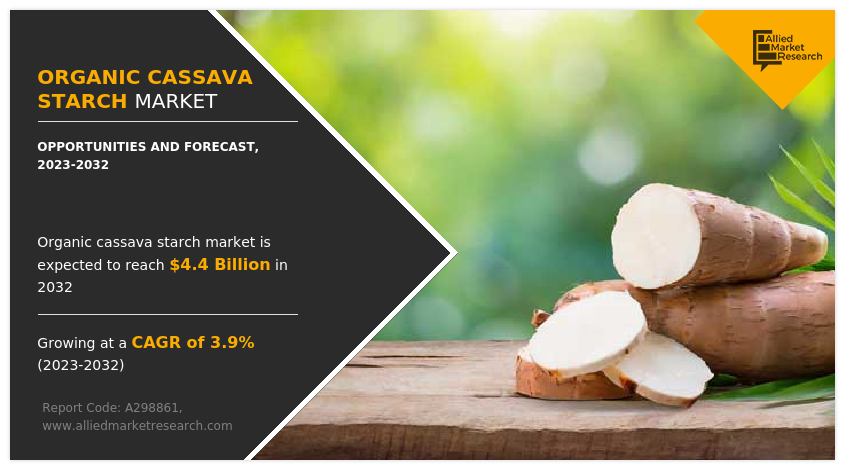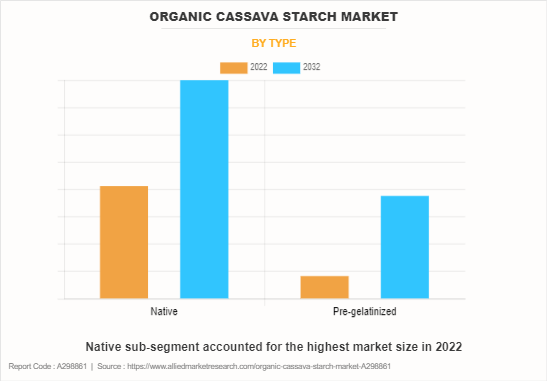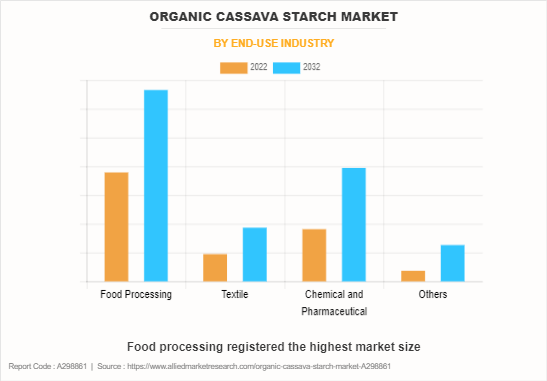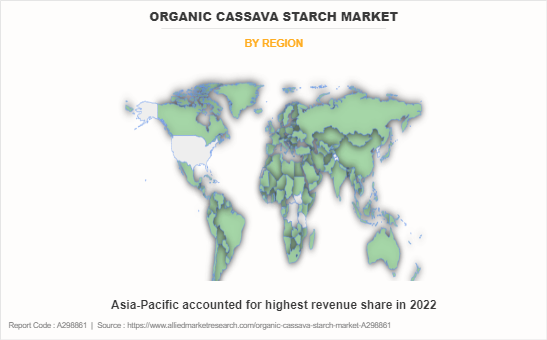Organic Cassava Starch Market Research, 2032
The global organic cassava starch market size was valued at $3 billion in 2022, and is projected to reach $4.4 billion by 2032, growing at a CAGR of 3.9% from 2023 to 2032.
Organic cassava starch is a type of starch derived from the cassava root through a process that involves grating and drying the root. It is a gluten-free alternative to wheat and other flours, making it suitable for individuals with gluten sensitivities or disorders. Cassava starch is commonly used in various food products such as bread, crackers, puddings, and as a thickening agent in sauces due to its neutral taste and versatile properties.

Key Takeaways of Organic Cassava Starch Market Report
- Based on type, the native sub-segment emerged as the global leader in 2022 and the pre-gelatinized sub-segment is anticipated to be the fastest growing during the forecast period.
- Based on end-use industry, the food processing sub-segment emerged as the global leader in 2022 and the chemical and pharmaceutical sub-segment is predicted to show the fastest growth in the upcoming years.
- Based on region, Asia-Pacific registered the highest organic cassava starch market share in 2022 and is projected to maintain its position during the forecast period.
Market Dynamics
Organic cassava starch serves as an excellent gluten-free alternative to wheat flour, making it suitable for individuals with celiac disease or gluten intolerance. Compared to other gluten-free flours like coconut or almond flour, cassava flour has a lower fat content and calorie density. This makes it a preferable option for individuals aiming to manage their calorie and fat intake. Cassava starch is a rich source of carbohydrates, providing a significant energy boost. This makes it a valuable dietary component, particularly in regions where it serves as a staple food. Organic cassava starch contains essential nutrients such as vitamin C, although in relatively lower amounts compared to other food sources. In addition, it offers small amounts of fiber, contributing to digestive health.
Organic cassava starch can be used in various culinary applications, including baking, cooking, and as a thickening agent. Its neutral taste allows for seamless integration into different recipes. While raw cassava contains cyanogenic glycosides, which can be toxic, proper processing methods such as soaking, boiling, roasting, or fermenting significantly reduce cyanide levels, ensuring the safety of cassava-derived products like organic cassava starch. Cassava is a resilient crop that can thrive in diverse environmental conditions, making it a sustainable source of starch production. Its ability to yield high calorie output per acre compared to cereal grains enhances its value as a staple food in developing countries. These factors are anticipated to boost the organic cassava starch market demand in the upcoming years.
However, organic farming relies on natural methods for pest and disease control, which may be less effective than synthetic pesticides and herbicides. This could lead to a higher susceptibility of the cassava crop to pests and diseases, potentially affecting the quality and quantity of the starch produced. In addition, obtaining and maintaining organic certification can be a costly process for farmers which in turn increases the cost of organic cassava starch for the consumers. In addition, the organic cassava starch may be less readily available in some regions compared to conventionally produced starch. Limited availability can be a disadvantage for industries or consumers looking for a consistent and accessible supply. These factors are anticipated to restrain the organic cassava starch market growth during the forecast timeframe. .
The beneficial properties of cassava starch, such as paste clarity, high viscosity, and freeze-thaw stability, position it as a valuable ingredient for various industrial purposes. This opens opportunities for the development of innovative products in industries that require these specific characteristics. The non-gluten, non-GMO, and non-allergenic nature of cassava starch makes it highly desirable in the gluten-free market. With an increasing number of consumers seeking gluten-free alternatives, there is a significant opportunity for organic cassava starch as a preferred ingredient in gluten-free bakery products. Cassava starch is already a major player in the sweetened and unsweetened bakery products industry. There is potential for further growth in the bakery and confectionery sector, with the versatility of cassava starch offering opportunities for the creation of new products such as cassava starch bars, cassava cakes, and cassava biscuits.
The use of cassava starch in the manufacturing of monosodium glutamate (MSG) presents a specific market niche, particularly in various Latin American countries. Opportunities exist for the expansion of organic cassava starch market and potential collaborations with MSG producers. Furthermore, with over 2,000 kinds of industrial products derived from cassava, there is room for diversification in the food industry. Cassava starch can be utilized in the production of various foods, including canned foods, frozen foods, soups, sausages, dairy products, and baby foods, presenting a wide range of opportunities. The introduction of new functional groups or changes in starch molecules to create modified starch enhances the performance of cassava starch. This opens up opportunities in the production of starch fudge, beverages, cold food, and flour, meeting the evolving demands of the food processing industry.
The introduction of new functional groups or changes in starch molecules to create modified starch enhances the performance of cassava starch. This opens up opportunities in the production of starch fudge, beverages, cold food, and flour, meeting the evolving demands of the food processing industry. Furthermore, cassava starch's potential use in the production of biodegradable materials aligns with the increasing global focus on environmentally friendly solutions. Opportunities exist to collaborate with industries working on sustainable practices and develop cassava starch-based alternatives to conventional materials. Also, the use of cassava starch in pharmaceuticals as binders, increasers, and disintegrants, as well as its application in cosmetics, opens avenues for collaboration with pharmaceutical and cosmetic companies looking for natural and versatile ingredients.
The global demand for cassava starch, especially in regions like Africa and Southeast Asia, provides opportunities for cassava starch manufacturers to explore international organic cassava starch markets. The relatively low cost of production in some regions may offer a competitive advantage. Thus, organic cassava starch presents diverse opportunities across various industries, from food and pharmaceuticals to textiles and biodegradable materials.
Segment Overview
The organic cassava starch market segmentation includes the organic cassava starch market by type, end-use Industry and region.
By Type
By type, the native sub-segment dominated the global organic cassava starch industry demand in 2022. Native cassava starch serves as a natural and organic source for food ingredients, meeting the increasing consumer demand for transparency and naturalness in their food choices. Extracted from cassava roots, it aligns with the preference for authentic, plant-based, and nutritious food sources. Certified as non-genetically modified organisms (Non-GMO), native cassava starch provides consumers with the assurance of a product free from genetic modifications. This aligns with the growing trend of consumers seeking clean and unmodified dietary options. The production of native cassava starch involves a meticulous process, starting from cassava field cultivation and ensuring the highest standards of hygiene during root washing. This results in the delivery of pure and clean starch products to consumers, meeting the demand for food safety and quality. Native starch is known for its versatility in various applications. It is insoluble in cold water, making it suitable for a wide range of food products.

By End-use Industry
By end-use industry, the food processing sub-segment dominated the global organic cassava starch market share in 2022. Organic cassava starch, specifically in the form of modified cassava flour (mocaf), serves as a valuable gluten-free alternative in the food processing sector. It replaces wheat flour in various products, addressing the increasing demand for gluten-free foods. Incorporating microalgae, such as Spirulina sp., into cassava-based products enhances their nutritional profile. Cassava doughnuts and cakes, made with organic cassava flour, experience a linear increase in protein, lipid, and fiber content, improving the overall nutrient density of the final products. The versatility of organic cassava starch allows for the creation of diverse food products, including noodles, sticks, and cookies, replacing traditional wheat-based options. Products like 'Nasamie' mocaf Spirulina noodles and 'Garmil' mocaf sticks showcase the range of offerings that cater to consumers seeking gluten-free and nutrient-enriched alternatives.
Cassava roots, rich in dietary fiber, contribute to heart health and digestive well-being. The combination of cassava with microalgae offers a potential solution to malnutrition by providing a sustainable protein source. In addition, the development of cassava-microalgae bioplastics presents an innovative and eco-conscious packaging material. These factors are driving the demand for organic cassava starch market in the food processing sector.

By Region
By region, Asia-Pacific dominated the global organic cassava starch market size in 2022. Asia-Pacific countries, particularly Thailand, boasts favorable climates and soil conditions conducive to robust cassava cultivation. The abundance of cassava resources ensures a stable and high-yielding supply, meeting the growing demand for organic cassava starch. The presence of a well-developed cassava processing industry in Asia-Pacific countries, exemplified by Thailand, Vietnam, Indonesia, and others, enables the production of diverse value-added cassava products. A wide range of products including starch, flour, chips, pellets, and ethanol can be efficiently manufactured from organic cassava, contributing to the region's capability to cater to various organic cassava starch market needs.
Asia-Pacific countries benefit from competitive production costs of cassava product. Factors such as affordable labor, government support, and geographical proximity to major export markets contribute to the cost-effectiveness of cassava products, enhancing their attractiveness on the global stage. In addition, robust government support, plays a pivotal role in driving the demand for organic cassava starch in the region. Financial assistance to farmers and processors, along with active promotion of cassava product exports, ensures a conducive environment for the industry growth. Furthermore, infrastructure development, digital solutions, and logistics optimization contribute to the efficiency and competitiveness of the organic cassava value chain in Thailand. These factors are anticipated to drive the Asia-Pacific organic cassava starch market expansion in the upcoming years.

Competitive Landscape
The key players profiled in organic cassava starch market report include Tate & Lyle, Cargill, Incorporated, Ingredion, Visco Starch, Global Sweeteners Holdings Ltd, Psaltry International Company Limited, Ekta International, Chorchaiwat Industry Co. Ltd., Matna Foods Ltd., and ADM.
Product development and business expansion are common strategies followed by major market players. For instance, in July 2023, Ajinomoto Co., Ltd.'s subsidiary, FD Green (Thailand) Co., Ltd., achieved a significant milestone by developing clean and Mosaic Disease-free cassava stems, aligning with the company's commitment toward sustainable practices outlined in The Ajinomoto Group Creating Shared Value (ASV) policy. The initiative aims to combat Cassava Mosaic Disease, a major threat to Thailand's cassava crops, which contribute significantly to the country's economy. The company has delivered qualified cassava stems to Asia Modified Starch Co., Ltd. and King Mongkut University of Technology Thonburi (Ratchaburi Learning Park) for testing, with plans to distribute them to farmers in 2024. This breakthrough is expected to benefit over 161 families and cover an area of approximately 1,088 rai, elevating sustainable cultivation practices among Thai farmers and boosting productivity through the use of clean and high-quality cassava stems.
Key Benefits for Stakeholders
- The report provides exclusive and comprehensive analysis of the global organic cassava starch market trends along with the organic cassava starch market forecast.
- The report elucidates the organic cassava starch Industry opportunity along with key drivers, and restraints of the market. It is a compilation of detailed information, inputs from industry participants and industry experts across the value chain, and quantitative and qualitative assessment by industry analysts.
- Porter five forces analysis helps analyze the potential of the buyers & suppliers and the competitive scenario of the market for strategy building.
- The report entailing the organic cassava starch market analysis maps the qualitative sway of various industry factors on market segments as well as geographies.
- The data in this report aims on market dynamics, trends, and developments affecting the organic cassava starch market opportunities.
Organic Cassava Starch Market Report Highlights
| Aspects | Details |
| Market Size By 2032 | USD 4.4 billion |
| Growth Rate | CAGR of 3.9% |
| Forecast period | 2022 - 2032 |
| Report Pages | 320 |
| By Type |
|
| By End-use Industry |
|
| By Region |
|
| Key Market Players | Tate & Lyle, ingredion, Chorchaiwat Industry Co. Ltd., Matna Foods Ltd., Global Sweeteners Holdings Ltd, Psaltry International Company Limited, Ekta International, Cargill, Incorporated, ADM, Visco Starch Company Limited |
The global organic cassava starch Market Size was valued at $3 billion in 2022, and is projected to reach $4.4 billion by 2032.
The global organic cassava starch market is projected to grow at a compound annual growth rate of 3.9% from 2023 to 2032 $4.4 billion by 2032.
The key players profiled in the reports includes Tate & Lyle, Cargill, Incorporated, Ingredion, Visco Starch, Global Sweeteners Holdings Ltd, Psaltry International Company Limited, Ekta International, Chorchaiwat Industry Co. Ltd., Matna Foods Ltd., and ADM.
Asia-Pacific dominated in 2022 and is projected to maintain its leading position throughout the forecast period.
Increasing consumer awareness and preferences for organic and natural products are driving the demand for organic cassava starch. The shift towards healthier and sustainable lifestyles is driving excellent opportunities in the organic cassava starch market.
Loading Table Of Content...
Loading Research Methodology...



